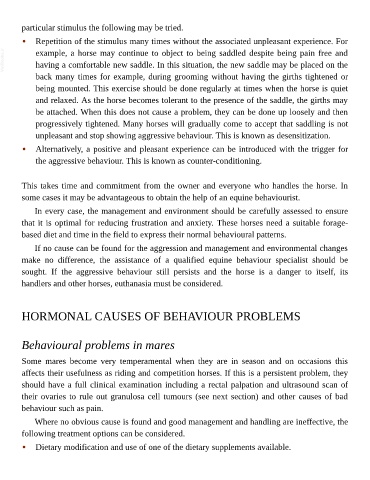Page 1028 - The Veterinary Care of the Horse
P. 1028
particular stimulus the following may be tried.
• Repetition of the stimulus many times without the associated unpleasant experience. For
VetBooks.ir example, a horse may continue to object to being saddled despite being pain free and
having a comfortable new saddle. In this situation, the new saddle may be placed on the
back many times for example, during grooming without having the girths tightened or
being mounted. This exercise should be done regularly at times when the horse is quiet
and relaxed. As the horse becomes tolerant to the presence of the saddle, the girths may
be attached. When this does not cause a problem, they can be done up loosely and then
progressively tightened. Many horses will gradually come to accept that saddling is not
unpleasant and stop showing aggressive behaviour. This is known as desensitization.
• Alternatively, a positive and pleasant experience can be introduced with the trigger for
the aggressive behaviour. This is known as counter-conditioning.
This takes time and commitment from the owner and everyone who handles the horse. In
some cases it may be advantageous to obtain the help of an equine behaviourist.
In every case, the management and environment should be carefully assessed to ensure
that it is optimal for reducing frustration and anxiety. These horses need a suitable forage-
based diet and time in the field to express their normal behavioural patterns.
If no cause can be found for the aggression and management and environmental changes
make no difference, the assistance of a qualified equine behaviour specialist should be
sought. If the aggressive behaviour still persists and the horse is a danger to itself, its
handlers and other horses, euthanasia must be considered.
HORMONAL CAUSES OF BEHAVIOUR PROBLEMS
Behavioural problems in mares
Some mares become very temperamental when they are in season and on occasions this
affects their usefulness as riding and competition horses. If this is a persistent problem, they
should have a full clinical examination including a rectal palpation and ultrasound scan of
their ovaries to rule out granulosa cell tumours (see next section) and other causes of bad
behaviour such as pain.
Where no obvious cause is found and good management and handling are ineffective, the
following treatment options can be considered.
• Dietary modification and use of one of the dietary supplements available.

